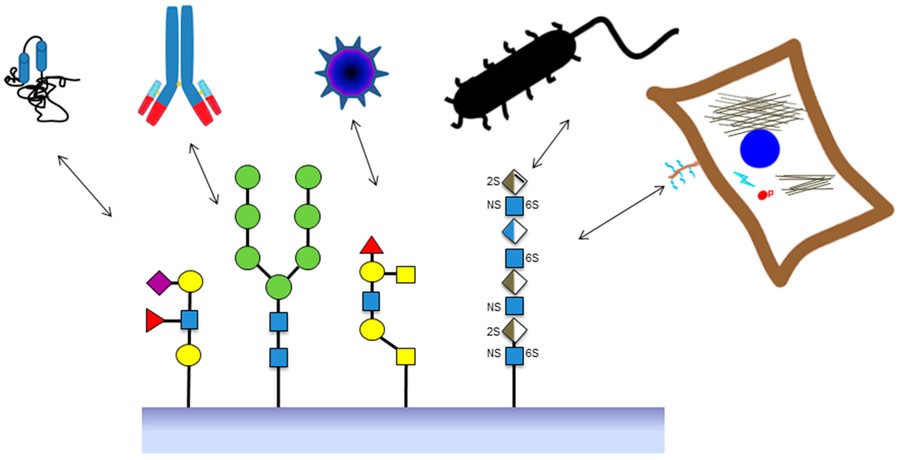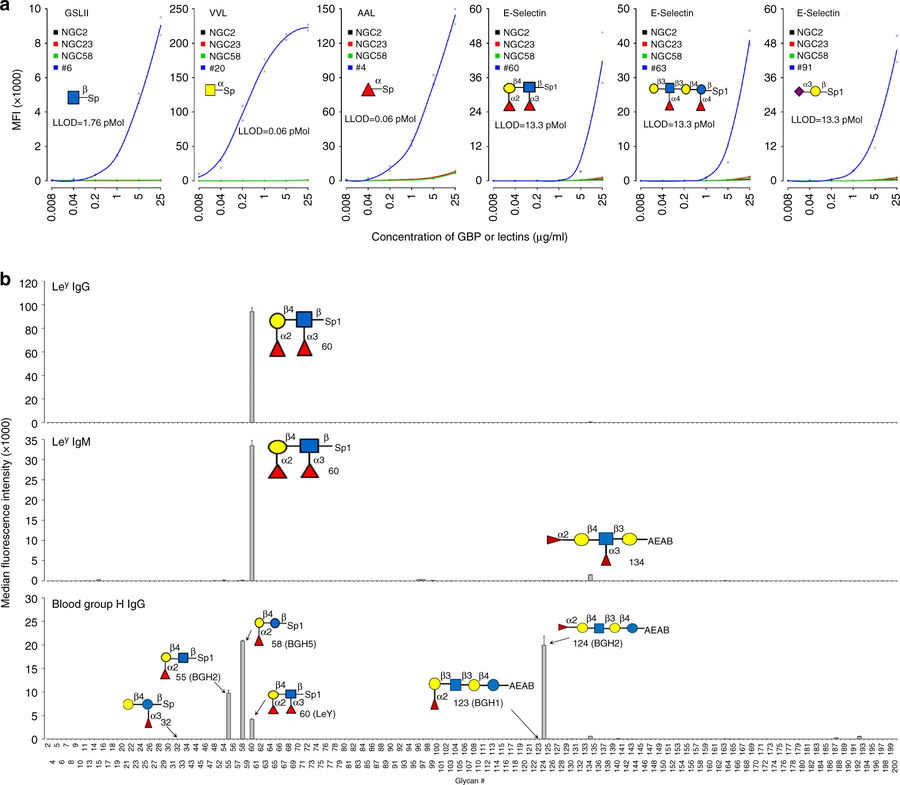Glycan Microarray based Detection Service
Accelerate Your Antibody Development!
Are you currently facing complex glycan analysis, limited throughput in screening, or challenges in precisely identifying specific glycan-binding interactions? Creative Biolabs' Glycan Microarray Based Detection Service helps you accelerate glycan analysis, achieve high-throughput screening, and precisely identify glycan-binding specificities through advanced glycan microarray technology and comprehensive detection platforms.
Contact our team to get an inquiry now!
Glycan Microarray
Glycan microarrays, alternatively termed carbohydrate biochips, consist of structurally varied saccharides immobilized on substrates through high-density spatial patterning. Their fabrication involves glycan probe synthesis followed by surface anchoring methodologies. Saccharides for immobilization may be naturally isolated or synthetically engineered. Diverse anchoring strategies exist, such as covalent conjugation (e.g., amine-reactive coupling) or affinity-based deposition (e.g., biotin-streptavidin systems). During interaction analyses, protein solutions are incubated on arrays to enable carbohydrate-ligand binding. Post-incubation, detection modalities—ranging from fluorescence-based systems to chemiluminescent readouts—are employed contingent on experimental objectives.
 Fig.1 The various applications of glycan arrays.1,3
Fig.1 The various applications of glycan arrays.1,3
Detection Methods of Glycan Microarrays
Binding quantification predominantly employs fluorophore-conjugated probes or an indirect detection system. Luminescence detection remains predominant due to exceptional sensitivity and accessibility of advanced fluorescence imaging systems, where emission signal magnitudes correlate with immobilized ligand densities. Concurrently, label-independent analytical platforms like Surface Plasmon Resonance (SPR) enable direct interaction analysis. SPR-based imaging facilitates continuous temporal tracking of molecular interactions while quantifying kinetic parameters and thermodynamic binding properties.
Discover more about our Glycan Microarrays
- N-Glycan Microarray Detection
- Glycan Microarray Detection
- Glycosphingolipid Glycan Microarray Detection
- MUC1 Glycopeptide Microarray Detection
- Heparan Sulfate Glycan Microarray Detection
- Human Milk Oligosaccharide Microarray Detection
- Blood Group Antigen Glycan Microarray Detection
- Lectin Microarray Detection
- Bacterial Glycan Microarray Detection
Advantages of Glycan Microarrays
Glycan microarray technology demonstrates distinct capabilities compared to traditional methods like ELISA in studying glycan-ligand interactions, particularly through:
- High-throughput screening of >10³ molecular interactions per assay platform
- Reduced reagent consumption while maintaining analytical precision with rare saccharide specimens
- Biomimetic spatial organization of oligosaccharides recapitulating natural glycan clustering patterns
Published Data
 Fig.2 Evaluation of MGBA's sensitivity and specificity.2,3
Fig.2 Evaluation of MGBA's sensitivity and specificity.2,3
A newly engineered multianalyte glycan bead array (MGBA) was recently introduced to address throughput constraints in carbohydrate interaction studies. This system facilitates parallel assessment of hundreds of carbohydrate-binding proteins across extensive sample sets, dramatically improving analytical capacity. Stringent verification via phytogenic lectins and recombinant anti-glycan antibodies established superior binding specificity, detection sensitivity, and methodological reproducibility. The platform's diagnostic applicability was demonstrated through extensive serum immunoprofile analysis (>900 samples), revealing novel glycan-reactive antibody patterns with ovarian cancer diagnostic relevance. These outcomes underscore the technology's pivotal advancement potential for both biomarker identification and precision oncology implementation.
What We Can Offer?
Creative Biolabs propels glycobiology discovery through an integrated portfolio of Glycan Microarray Services addressing multifaceted R&D objectives. Harnessing two decades of expertise and cutting-edge microarray platforms, we deliver:
- Custom Glycan Array Screening: Design and fabrication of bespoke glycan arrays tailored to your specific research questions, ensuring the most relevant glycan targets are included.
- High-Throughput Anti-Glycan Antibody Profiling: Rapid and comprehensive screening of serum, plasma, or purified antibodies against hundreds of glycan targets to identify specificities and repertoire changes.
- Host-Pathogen Interaction Studies: Detailed analysis of how pathogens interact with host glycans, providing critical insights for vaccine and antiviral development.
Experience the Creative Biolabs Advantage - Get a Quote Today
Why Choose Us?
Our Glycan Array Detection Service distinguishes itself through integrated cutting-edge microarray platforms, domain mastery, and dedicated project stewardship, accelerating your translational research objectives.
- Exceptional Glycan Library Diversity: Industry-leading collection incorporating natural and synthetic structures, enabling exhaustive screening capacity.
- Advanced Array Performance: Covalent conjugation technologies with rigorous QC ensure uniform, stable arrays exhibiting minimal batch variance.
- Multiplexed Analytical Capabilities: Integrated systems deliver high-sensitivity fluorescence, label-free SPRi kinetics, and orthogonal MS verification, providing binding kinetics quantification and structural validation.
- Glycoproteomics Specialization: Our team leverages decades of experience, delivering GLP compliant experimental design through bioinformatic interpretation, converting intricate datasets into actionable biological intelligence.
- Tailored Solutions for Complex Challenges: We specialize in developing custom glycan array solutions for unique research questions, including those involving rare glycans or challenging biological samples.
FAQs
Q: What sample types can be analyzed through Creative Biolabs' Glycan Array system?
A: The system enables extensive profiling of diverse biological samples, encompassing affinity-purified proteins (e.g., carbohydrate-binding lectins, immunoglobulins, cytokine regulators), unprocessed specimens like whole blood derivatives, cellular lysates, and structurally intact biological entities, including viable eukaryotic cells, prokaryotic cultures, or enveloped virions. Tailored preprocessing protocols are engineered by our specialists to maximize analytical sensitivity aligned with experimental objectives.
Q: What distinguishes glycan microarray technology from conventional analytical techniques such as ELISA or SPR?
A: Glycan microarrays enable parallelized screening of 10²–10³ molecular interactions per assay platform, surpassing ELISA's sequential workflow limitations. Unlike SPR's single-interaction focus, they perform multichannel analysis while conserving rare biological samples. Additionally, their design replicates physiological multivalent ligand topology, a critical factor in natural glycan recognition processes that SPR typically cannot resolve.
Q: How does multivalent glycan clustering enhance microarray binding analysis?
A: The "cluster effect" describes a high-density spatial arrangement of glycans through multivalent anchoring on microarray substrates, recapitulating native cell surface glycan topologies. This architecture achieves logarithmic avidity amplification versus monovalent formats, essential for identifying low affinity interactions dependent on synergistic multivalent binding. Such engagement replicates physiological environments where glycan protein recognition governs immune effector functions and pathogen adhesion mechanisms, guaranteeing assay outputs mirror physiologically congruent interaction profiles.
Related Products
To further support your research and development in glycobiology, Creative Biolabs offers a suite of products:
- Monoclonal Antibodies
- Polyclonal Antibodies
- Secondary & Tag Antibodies
- Isotype & Loading Control Antibodies
- Carbohydrate Antigens
Creative Biolabs offers a series of anti-glycan antibody-related services for worldwide customers. To explore these capabilities, please contact us for more information.
References:
- Puvirajesinghe, Tania M, and Jeremy E Turnbull. "Glycoarray Technologies: Deciphering Interactions from Proteins to Live Cell Responses." Microarrays (Basel, Switzerland) vol. 5,1 3. 4 Jan. 2016, DOI:10.3390/microarrays5010003
- Purohit, Sharad et al. "Multiplex glycan bead array for high throughput and high content analyses of glycan binding proteins." Nature communications vol. 9,1 258. 17 Jan. 2018, DOI:10.1038/s41467-017-02747-y
- Distributed under Open Access license CC BY 4.0, without modification.
